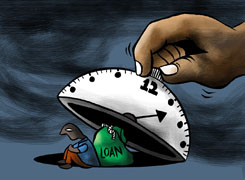Ramalingam Kalirajan |10071 Answers |Ask -Follow
Mutual Funds, Financial Planning Expert - Answered on Jun 07, 2024
He has an MBA in finance from the University of Madras and is a certified financial planner.
He is the director and chief financial planner at Holistic Investment, a Chennai-based firm that offers financial planning and wealth management advice.... more

Hello, I want to buy a car. However my salary is only Rs. 30k per month. I only have Rs. 1.5 lakhs in my savings. First hand car will cost me around 8-9 lakhs. Help how to make provision so that I can finally buy a brand new car
Assessing Your Current Financial Situation
Your monthly salary is Rs. 30,000, and your savings amount to Rs. 1.5 lakhs. A new car costs around Rs. 8-9 lakhs, which is significantly higher than your current savings. Here’s how to proceed.
Monthly Income and Expenses Breakdown
First, evaluate your monthly income and expenses. This step will help identify areas where you can save more.
Income: Rs. 30,000 per month
Essential expenses: Rent, utilities, groceries, transportation, etc.
Non-essential expenses: Entertainment, dining out, subscriptions, etc.
Creating a Savings Plan
Increase Savings Rate
To buy a car, you need to save more aggressively. Aim to save at least 20-30% of your income. Here’s how you can do it:
Cut down non-essential expenses: Reduce spending on entertainment, dining out, and subscriptions.
Re-evaluate essential expenses: Look for cheaper alternatives for rent and groceries.
Establish an Emergency Fund
Before making any major purchase, ensure you have an emergency fund. This fund should cover at least 6 months of essential expenses.
Monthly savings goal: Set aside a portion of your savings for the emergency fund.
Automate savings: Set up automatic transfers to your savings account.
Exploring Financing Options
Buying a car outright may not be feasible right now. Consider financing options to spread the cost.
Car Loans
A car loan can make purchasing a car more manageable. However, assess your ability to repay.
Down Payment: Use your Rs. 1.5 lakhs as a down payment to reduce the loan amount.
EMI Calculation: Ensure the monthly EMI does not exceed 15-20% of your income.
Personal Loans
Personal loans offer flexibility but usually have higher interest rates than car loans. Compare options.
Interest Rates: Shop around for the best interest rates.
Loan Tenure: Choose a tenure that offers manageable EMIs.
Budgeting for Ongoing Costs
Owning a car involves ongoing costs beyond the purchase price. Factor these into your budget.
Insurance
Car insurance is mandatory and adds to your monthly expenses.
Premium Costs: Research and compare insurance plans.
Coverage: Choose a plan with adequate coverage at a reasonable premium.
Maintenance
Regular maintenance is crucial for the car’s longevity.
Service Costs: Budget for routine services and unexpected repairs.
Fuel Expenses: Estimate monthly fuel expenses based on your usage.
Depreciation
A new car depreciates quickly. Understand the depreciation curve and its impact on resale value.
Alternative Options
Given your financial situation, consider alternatives to buying a new car.
Pre-Owned Cars
Pre-owned cars are more affordable and depreciate slower than new cars.
Lower Purchase Price: Find a reliable pre-owned car within your budget.
Inspection: Have the car inspected by a trusted mechanic.
Leasing
Leasing allows you to use a car without the long-term commitment.
Lower Monthly Payments: Lease payments are typically lower than loan EMIs.
Flexibility: At the end of the lease term, you can choose to buy the car or lease a new one.
Investing Wisely
While saving for a car, invest your savings to grow your wealth. Avoid risky investments; choose stable options.
Mutual Funds
Invest in mutual funds to potentially earn higher returns than a savings account.
Systematic Investment Plan (SIP): Start a SIP to invest regularly.
Diversified Portfolio: Choose funds with a diversified portfolio to mitigate risks.
Fixed Deposits
Fixed deposits offer safety and predictable returns.
Short-term Goals: Use FDs for short-term savings goals.
Interest Rates: Compare interest rates from different banks.
Professional Advice
Consider consulting a Certified Financial Planner (CFP) for personalized advice.
Customized Financial Plan
A CFP can help create a customized financial plan based on your goals and financial situation.
Goal Setting: Define clear financial goals and create a roadmap to achieve them.
Investment Strategy: Develop an investment strategy tailored to your risk tolerance and time horizon.
Practical Considerations
Given your current financial constraints, it may be wise to delay the purchase until you’re more financially stable.
Building a Strong Financial Foundation
Focus on building a strong financial foundation before making a large purchase.
Debt Management: Avoid taking on debt that you may struggle to repay.
Savings Growth: Prioritize growing your savings and investments.
Long-term Financial Health
Consider the long-term impact of a car purchase on your financial health.
Opportunity Cost: Understand the opportunity cost of tying up a significant portion of your savings in a car.
Financial Flexibility: Maintain financial flexibility to handle unexpected expenses.
Realistic Timeline
Set a realistic timeline to achieve your goal of buying a car. This timeline should consider your savings rate, investment growth, and potential financing options.
Short-term Goals
Focus on short-term goals to improve your financial situation.
Increase Savings: Aim to save a specific amount each month.
Improve Credit Score: Ensure a good credit score to qualify for better loan terms.
Long-term Goals
Align your car purchase with your long-term financial goals.
Financial Stability: Ensure you’re financially stable before making a large purchase.
Future Planning: Consider your future financial needs and plan accordingly.
You’ve taken a significant step by assessing your financial situation and planning for your goal. This proactive approach is commendable.
Recognize Your Efforts
Recognize the efforts you’re making to secure your financial future. This discipline will serve you well in achieving your goals.
Stay Motivated
Stay motivated and focused on your goals. The sacrifices you make now will lead to greater financial security and freedom.
Conclusion
Purchasing a car is a significant financial commitment. Given your current salary and savings, it’s essential to approach this decision strategically. Focus on increasing your savings, exploring financing options, and investing wisely. Consider alternative options like pre-owned cars or leasing. Consult a Certified Financial Planner for personalized advice. By building a strong financial foundation and setting realistic goals, you can achieve your dream of buying a car without compromising your financial health.
Best Regards,
K. Ramalingam, MBA, CFP,
Chief Financial Planner,
www.holisticinvestment.in
You may like to see similar questions and answers below
Ramalingam Kalirajan |10071 Answers |Ask -Follow
Mutual Funds, Financial Planning Expert - Answered on May 06, 2024
Ramalingam Kalirajan |10071 Answers |Ask -Follow
Mutual Funds, Financial Planning Expert - Answered on Jul 17, 2024
Ramalingam Kalirajan |10071 Answers |Ask -Follow
Mutual Funds, Financial Planning Expert - Answered on Jul 12, 2024
Ramalingam Kalirajan |10071 Answers |Ask -Follow
Mutual Funds, Financial Planning Expert - Answered on Jul 19, 2024
Komal Jethmalani |410 Answers |Ask -Follow
Dietician, Diabetes Expert - Answered on Aug 02, 2025
Prof Suvasish Mukhopadhyay |2744 Answers |Ask -Follow
Career Counsellor - Answered on Aug 02, 2025
Prof Suvasish Mukhopadhyay |2744 Answers |Ask -Follow
Career Counsellor - Answered on Aug 02, 2025
Dr Nagarajan J S K |2129 Answers |Ask -Follow
NEET, Medical, Pharmacy Careers - Answered on Aug 01, 2025
Dr Nagarajan J S K |2129 Answers |Ask -Follow
NEET, Medical, Pharmacy Careers - Answered on Aug 01, 2025
Dr Nagarajan J S K |2129 Answers |Ask -Follow
NEET, Medical, Pharmacy Careers - Answered on Aug 01, 2025
Radheshyam Zanwar |6064 Answers |Ask -Follow
MHT-CET, IIT-JEE, NEET-UG Expert - Answered on Aug 01, 2025
Dr Nagarajan J S K |2129 Answers |Ask -Follow
NEET, Medical, Pharmacy Careers - Answered on Aug 01, 2025
Ramalingam Kalirajan |10071 Answers |Ask -Follow
Mutual Funds, Financial Planning Expert - Answered on Aug 01, 2025
Ramalingam Kalirajan |10071 Answers |Ask -Follow
Mutual Funds, Financial Planning Expert - Answered on Aug 01, 2025























